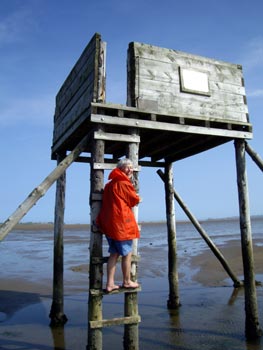


|
|
||||
 |
||||
 |
||||
 |
||||
 Over 600 years ago, the poet Geoffrey Chaucer wrote these words in his General Prologue to the Canterbury Tales: “When that Aprille with his showres soote ... And the 12th line reads: And so it was that in sweet showered April, in emulation of the bard, that Barbara and Rod set out on pilgrimage to Holy Island (known as Lindisfarne before the year 1084). As of old, there was interesting staging posts on the way. The first main stop was in that vibrant city of Birmingham, where, amongst many sights to behold - the art gallery (where there was an excellent exhibition of the works of Burne Jones), the sculptures, the new architecture, we were deeply saddened by the squalid back-to-back houses, now preserved as pieces of social history. Here, large families of artisans had to scrape a living - jewellers, glass eye makers, tailors.... In pitiful surroundings. Our second stop at Haltwhistle was near to the site of Hadrian’s Wall. The village has a large boulder in its centre which proclaimed the geographic centre of the Kingdom. The local priest obligingly opened the church for us where we admired the magnificent stained glass windows, by coincidence designed by Burne Jones. We walked some miles of the Roman Wall and heard the local tales of the ‘Reevers’ and the Armstrong gang who had terrorised the local population. Some of the wall had been demolished to quarry stone (it is now a picturesque lake). The dolorite stone thus extracted had another outcrop at our final destination. Holy Island is close to the Northumbrian coast to the south of Berwick-upon-Tweed. At high tide it is completely cut off from the mainland. Nowadays vehicles can reach it along a causeway, but for centuries the route was over the sands at low tide - the Pilgrim’s Way, which is now marked by 270 poles along the track. In the last century two refuges were constructed on the way, in the event of pilgrims being caught by the rush of water. Many casualties have occurred here, and still victims are claimed as drivers along the causeway attempt unsuccessfully to beat the tide. Barbara and Rod made the crossing on foot, meditating and reflecting as we walked painfully barefoot the 2½ miles to the shore. We found accommodation in the Retreat of the Community of Aidan and Hilda, there meeting others of an ecclesiastical connection, worshipping and praying with them. The island itself is spiritually uplifting in its solitude and we were ever conscious of its profound history. Evening service was conducted at the waterside and at first we found this quite unsettling and were perturbed by the spontaneous nature of the proceedings. In AD634 Oswald, King of Northumberland, sent to Iona for Christian teachers. Aiden was sent with a group of Irish monks. From the island Bishop Aiden evangelised the whole of Northumbria. In AD685 Cuthbert became Bishop of Lindisfarne but he retired to a cell in a more remote Farne Island where he died in AD687. Now his remains lie in a shrine in Durham Cathedral, the spot being marked by a stone merely inscribed CUTHBERTUS. As is well known, the famous Lindisfarne Gospels were written and illuminated here. A translation of the end note in the text reads: “Eadfrith, Bishop of the Church of Indisfarne, he wrote this book for God and St Cuthbert and for all the saints that are in the island, and Ethelwald, Bishop of those Lindisfarne Island bound and covered it outwardly as well as he could. And Billfrith the anchorite he wrought as a smith the ornaments that are on the outside and adorned it with gold and with gems, also with silver and gilded, a treasure without deceit. And Aldred, an unworthy and most miserable priest, with God’s help and St Cuthbert’s over glossed it in English.” It is Rod’s opinion that this priest Aldred provided an early example of graffiti, for his calligraphy is execrable and totally unfitting to stand beside the glorious penmanship of Eadfrith. Notwithstanding this, it is clear insight into the making of this wondrously crafted book. There are 250 pages of vellum and it contains not only the four Gospels (after the translation of St Jerome)l, but also two Epistles and the Eusebian Canons. It is possible to view the pages on-line, a page-turning programme is in the British Library and a facsimile copy resides in the Parish Church of St Mark in Holy Island. Among the other wonderful features in the Church are two carpets. One was made by 18 women of the Island, the design being taken from the opening page of St Mark in the Lindisfarne Gospels. A smaller one, with a design in St Luke’s Gospel is in front of the Fishermen’s Altar. Holy Island also contains an impressive castle, the interior of which was extensively remodelled by Sir Edwin Lutyens. There are also the red sandstone ruins of the 11th century priory church, where the visitors may wander around and conjecture what life would have been like in those cloistered walls. At the end of their sojourn, pilgrims are given a valedictory blessing after the final devotional service. Pilgrimages are spiritually nurturing, including the Chaucerian purpose: “The holy blisful martyr for to seke.” Rod Dawson |
|
page last updated |